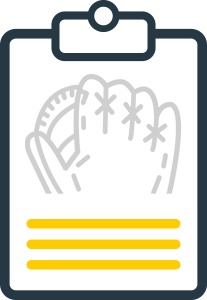So you’re looking to add a curveball to your game but aren’t quite sure how to throw one? No problem. We’re about to break down the simple steps for you to learn how to throw a curveball and improve your pitching arsenal.
The art of pitching is all about keeping hitters off-balance, and having a speed-changing, plane-defying curveball is a great way to do that. Curveballs are among the slowest pitches in baseball. They break away from the arm-side while tumbling down as they approach the plate. And hitters that think they are sitting on a fastball are in for an unpleasant surprise, often swinging and missing or they roll over a soft ground ball to the pull side. It’s a deceptive pitch, just don’t hang one…
5 Steps to Throw a Curveball
- Find your grip. The most common way pitchers throw grip a curveball is by aligning the middle finger on the inside of the ball’s horseshoe seam with the index finger gently resting next to it.
- Load your arm in a typical fashion. Players often develop arm or shoulder injuries by “cocking” their curveball as they begin their arm motion. Instead, treat the beginning portion of your wind-up similar to that of your fastball.
- Get on top of the ball. Once your shoulder has rotated during the throwing motion, think about getting your fingers on top of the ball because, unlike a fastball, your fingers will finish in front of the ball at the time of release. Get on top of the pitch at the apex of your motion.
- Pull the string. Use the leverage of your grip to pull down (with your fingers in front of the ball) to create the ball’s rotation at release. The more your curveball spins, the more your curveball will break.
- Finish the pitch. Pitchers have a tendency to short-arm their curveballs. Extend your arm at release, pull it down across your body to your opposite hip, and square up your arm-side hip to home plate. This will help ensure both consistency in your curveball and safety for your arm.
The steps to throwing a curveball are straightforward, but mastering the art of throwing a good one can take a lifetime. We encourage pitchers deemed “old enough” by their parents/coaches to take the time to practice throwing curveballs during bullpen sessions to understand how their curveball moves and how to appropriately incorporate it into their game plan.
Curveball Nicknames
The hardest part of any pitcher gaining a new curveball may not have anything to do with learning how to throw it. Instead, it’s all about finding the proper nickname for the new pitch. For years pitchers have been developing their own unique nicknames to best describe their nasty curveballs. The following are a few ideas to get your imagination churning as you work to immortalize your curveball forever:
- The Hook
- Yakker
- Deuce
- Uncle Charlie
- Lord Charles
- Public Enemy No. 1
- The Hammer
- Yellow Hammer
- Drop Down
- Knee Buckler
History of the Curveball
As is the case with most early baseball history, the origin of the curveball is slightly muddled. For the longest time, Candy Cummings was credited with the invention of the curveball in 1870. However, the New York Clipper ran a story on Phonney Martin back in 1869. The report claimed that Martin was an “extremely hard pitcher to hit for the ball never comes out in a straight line, but in a tantalizing curve.” Either way, we can trace the inception of the curveball back to the late 1860s and early 1870s.
Princeton University became the first organized baseball team to adopt the mind-bending pitch. They taught their pitchers how to throw it and their hitters how to hit it. But this “act of deception” was not received well by rival Ivy League competition. Harvard President Charles Eliot was vocally opposed to the pitch. Threats were made around the league to not play any scheduled games against Princeton. However, it appears they were merely empty threats as records show every game was played during these times of unrest. Harvard and company likely learned how to throw a curveball, and competitive balance was once again restored.
Soon after, the curveball began making its way through the Major League ranks. Professional pitchers around the country adopted the deceptive pitch to keep hitters off-balance. It was initially met with hesitation around the League, until people began to see the depth and strategy it brought to pitching. The game proved it had the ability to evolve and pitchers now had a secret weapon up their sleeves that forced hitters to react.
---If you enjoyed reading this piece on all things curveballs, we encourage you to check out some of our other blog articles. We primarily focus on baseball gloves and softball gloves, but we also like to break from the norm and just talk about elements of our beautiful game. For those looking to pick up a new glove, be sure to contact our team of Glove Experts via phone, email, or live chat. We’re more than happy to talk about the game with you. It’s more than just a slogan; we’re really here for you from Click to Catch!




